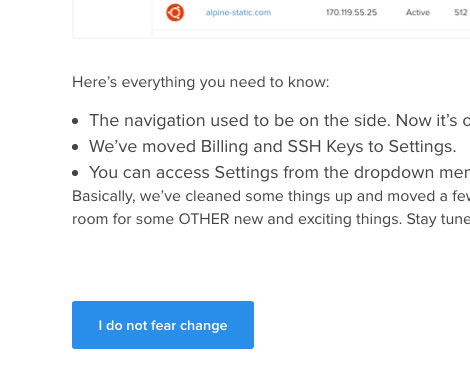Fear is an innate human emotion induced in response to a danger or threat whether real or otherwise. Fear stops us from walking in front of a bus or picking up spiders. Fear can also push us into making poor decisions or cripple us into inaction.
While fears manifest themselves in people in different ways, there is a common set we face as professionals. Recognising these fears can helps us manage those fears and improve our work and lives.
Life with no fear
Former US president Franklin D. Roosevelt is often quoted about fear:
“The only thing we have to fear is… fear itself”
With all respect, Mr Roosevelt is off the mark here: there are plenty of things that we are quite right to be afraid of.
There is one know person who lacks the ability to fear and she’s the subject of the study “The human amygdala and the induction and experience of fear”. That person, known as SM, was taken through a series of fear-inducing situations to see what would happen.
Taken to a pet store, SM was exposed to snakes, spiders and other dangerous creatures. She was driven by an overwhelming sense of curiosity: “SM asked 15 different times if she could touch one of the larger [poisonous] snakes.”

Waverly Hills Sanatorium. Looks friendly.
During Halloween, they took SM to the Waverly Hills Sanatorium, ranked as one of the ‘most haunted’ places in the world. Because roaming through a haunted sanatorium at night isn’t scary enough, the researchers added people dressed in scary costumes through the building. She laughed when monsters leapt out at her while other neutral participants were petrified.
“As the other members of the group lagged behind her, she would repeatedly call out, ‘This way guys, follow me!’”
While fear is an important part of how we function, the challenge is to strike a balance between being frozen by the fear and getting on with our lives.
Fear of the unknown
When we are confronted by something new to us or something we haven’t done before, fear of the unknown — xenophobia — kicks in.
There’s a lot of evolutionary biology that drives fear of the unknown. If confronted by something we don’t know, it’s safer to err on the side of caution.
This extends to skewing initial responses to the negative when confronted with something new. New colour? I like the old one. New design? It’s okay, but I prefer the old one. Ask anyone who’s launched, well, anything: the initial reaction is often bad.
Whenever we try something different or unfamiliar, we face a negative-skewed response both from ourselves and others.
Fortunately, there is a cure: exposure over time. This is great unless we’re trying to actively introduce new ideas — otherwise known as being creative.
How then do we spark creativity in ourselves? The answer is to embrace the culture of disruption, ask questions, conduct research.
Fear of failure
Something of an extension of fear of the unknown, fear of failure holds us back from trying something new: what happens if it doesn’t work?
The precautionary principle has strong parallels with the fear of failure: any action that might cause harm should be avoided; try without error, succeed without failure.
This leads us into stagnation where any action is to be avoided for fear the outcome will be negative. Anything other than a thorough success is perceived as failure.
Creating a culture that rewards contained failures can help counter fear of failure. Fail early, fail often. Make mistakes so you can learn.
Far better to try and fail than to not try at all. Inaction is an action.
Fear of inadequacy
There’s a curious dichotomy with feelings of inadequacy expressed in the chasm between impostor syndrome and the Dunning-Kruger effect. Imposter syndrome is experienced by a person performing a task who feels that they are grossly incapable of performing that task and, sooner or later, will be exposed as a fraud. Dunning-Kruger describes a false sense of grandeur demonstrated by the incompetent.
Self-doubt is the key symptom of the fear of inadequacy: “I lack the skill/experience/knowledge to suggest a change. Sooner or later, I’ll be found out because I don’t know what I’m doing.”
Of all the fears discussed here, I find fear of inadequacy and imposter syndrome to be the most crippling. “Who am I to write this article? Why would anyone want to read it?”
The best counter I’ve found to date is the comfort in knowing that we’re not alone in experiencing this fear. Relying on peer pressure in a good way, if others have leapt into the unknown before us, we can too.
Representation helps immensely here too. Minorities — whether ethnic, gender, age, experience — are particularly vulnerable to fear of inadequacy. Even one pioneering representative can immeasurably help those who associate with them.
From the many little girls inspired by Gal Gadot’s Wonder Woman (justhiceieague, MrFilmkritik) to the love of Pixar’s Coco from the Mexican community (jose_esparza, upcomingpixar), the impact of seeing others who we can associate with is immediately apparent. Software engineering professor Cecilia Aragón was helped by talking to a senior women in the same field.
Fear of missing out
Reduced in English to FoMO, fear of missing out captures the feeling that if everyone else is doing something, it must be good. This feeling drives us to follow trends without understanding them.
Greater complexity lends itself to lower likely understanding and greater risk. But hey, if Google/Facebook/Microsoft/Snap/Apple/Amazon are doing it, what could be wrong?
Walking further down this path, we end up in the territory of cargo cult behaviour: linking false correlation to effect. Look no further than the countless variations of the Agile manifesto that have little to do with the original.
Becoming locked into apparently safe cycles leaves us at risk of being left behind as the world changes around us. We are pack creatures by nature, yet standing out from the crowd is what leads to success.
Allay your fears with… science!
The scientific method provides a way to tackle complexity in a rational way. Reducing the method slightly, we have question, research, prototype, test and review.

Is there anything science can’t fix?
Question
Australian science educator Dr Karl Kruszelnicki notes that it’s not the answer that gets you the Nobel Prize, it’s the question. Instead of accepting the status quo, we should ask questions, prompt discussion and look for a different way.
When we are asking questions, it is ever important not to take it too far. Follow a constructive line to avoid falling into whataboutery — notably identified by the Guardian’s comment moderators as a form of trolling.

Digital Ocean are well aware of humanity’s change-resistance
Research
Within hierarchies, formal or otherwise, opinions can be hard to overcome. The worst ungrounded opinions come in the form of the highest paid person’s opinion (HiPPO) whereby the most senior person involved in a decision wins by default.
Being a subject-matter expert isn’t enough — research is essential to move toward a grounded hypothesis. Change the conversation from “I think…” to “My research shows…”. You won’t win every battle but you can at least elevate the level of discussion.
Research doesn’t need to be an over-wrought process. Finding out what everyone has done (meta-analysis) is an easy yet important way to get started. When choosing a front-end JavaScript framework at CXA Group, we relied heavily on meta-analysis research as part of the evaluation process.
Prototype
With a hypothesis in place, the next step is to try it out in low-risk experiments: fail early, fail often. When you try a variety of methods, you’ll learn about what works and what doesn’t even when the solution seemed obvious at the start.
Integrating prototyping into project planning can help provide motivation during the process with a series of targets that can be achieved along the way. Prototypes don’t even need to be seen by anyone else to be useful for the people building them.
Fear of inadequacy can strike here. How much is enough? What have we not taken into consideration? Engaging in the process alone is an awfully good start. Sleep easy knowing that you’ve made a solid attempt.
Test
Once you have a prototype that’s survived several revisions, it’s time to test it out. It’s very important to accept failure at this point, however difficult that may be. Does it stand up to expectations? If not, refine, revise and try again.
Successful testing is tied to the quality of the tests. The closer to reality, the stronger the testing. This can be difficult depending on what exactly is being tested but, once again, making an effort to do the right thing is better than not trying at all.
Review
Design is never done. Software is never finished. Observe your product to see if the original hypothesis still holds. If it doesn’t, the cycle begins again and we ask new questions.
You’ll often fight pressure to continue on to the next project or development phase without conducting a review especially when you’re under time pressure. If you don’t review, you’ll have never really tested your hypothesis and never know if you ever achieved anything.
Important in the review phase is the concept of a measured success which helps us rationalise our performance. Did we succeed enough to make a difference? Even what might initially seem like an abject failure is a measured success if we can learn from the experience and avoid a repeat.
Amazon’s Kindle, along with the electronic book market as a whole, was tipped to substantially shake up the printed book market if not replace it entirely. History shows this didn’t happen at all and, in the last few years, electronic book sales have plateaued as printed books retain their dominance of the market.
Is the Kindle a success? It’s easy to come to the conclusion that it isn’t, as it hasn’t reached the potential it might have and yet, the device has captured the attention of dedicated readers and carved a significant niche for itself in the market.
The magic formula
Looking at filmmaker Brad Bird’s directing career, we see him go from The Iron Giant (rated at 96% approval on Rotten Tomatoes) to The Incredibles (97%) to Ratatouille (96%) to Mission: Impossible Ghost Protocol (94%) to Tomorrowland (49%). Reflecting on his process in an interview with Screen Rant, he notes:
You don’t know whether it’s going to work or not, you think it will. You con everybody into thinking, “It’s gonna work, absolutely!” when the truth is you have a lot of confidence with it but you don’t know for sure, particularly if you’re doing something new.

Reading this article might not win you an Oscar, but do leave a comment if it does.
In this we can find something to ease our fears — there is no magic formula. The feeling of inadequacy is perfectly normal. The perfection we see elsewhere is nothing more than an illusion.
What have you got to lose?
Steve Sasson invented the digital camera in 1975 while working at Kodak. With Robert Hills, he invented the first DSLR in 1989 but Kodak decided not to bring the invention to market for fear of encroaching on their film sales. The company licensed the technology to camera makers but never really took advantage of the invention for themselves.
When the film market collapsed with the rise of DSLRs and camera phones in the 2000s, Kodak were left with nothing to fall back on and eventually filed for bankruptcy in 2012.
What have you got to lose? The answer is everything. Worse, we may have already lost it and not realised yet. Knowing this actually makes it easier.
“Until you’ve lost your reputation, you never realise what a burden it was or what freedom really is.”
– Rhett Butler in Gone with the Wind
Our fears are real and, in the end, the only way to tame them is to tackle them head on. Don’t get too comfortable no matter what life throws at you and you won’t be left on the sidelines.
I don’t know where I’m going from here but I promise it won’t be boring.
– David Bowie
Comments
Please remember that all comments are moderated and any links you paste in your comment will remain as plain text. If your comment looks like spam it will be deleted. We're looking forward to answering your questions and hearing your comments and opinions!